TLDR
POKT Network builds a decentralized RPC node network, which is of great significance to the decentralization of Web3 data. Compared with centralized providers, POKT Network has higher scalability, lower maintenance and operation costs, lower usage fees and more stable infrastructure, avoiding transaction review and centralized failures.
POKT Network has completed the early launch of the DePIN network, the number of nodes and business data are constantly growing, and the token economic parameters are being continuously adjusted to reduce the inflation rate, transitioning from early launch to sustained development.
POKT Network has recently launched the modular strategy of Gatewayverse, which will separate the demand side into multiple independent gateway operators. The protocol itself will focus on becoming an underlying protocol that supports different gateway requirements, focusing on the stimulation and construction of node groups.
POKT Network is committed to becoming a universal data service provider and opening up the market for non-Web3 native services. The main business currently being developed is open source LLM hosting. The opening to the LLM inference market will greatly increase the market and demand for the POKT network, but the specific implementation situation still needs further observation.
From a financial perspective, POKT tokens have been fully unlocked, the token inflation rate is continuously decreasing, half of the POKT token circulation is used for pledge, and the chip structure is concentrated. From a financial perspective, it is a good target.
1 Which aspect of decentralization does POKT Network make up for?
To understand POKT Networks position in the industry, you should first answer the question: Which link in the industry does POKT Network make up for the lack of decentralization? Why is POKT Network indispensable to the development of the industry? We start with the two most basic links of writing and reading blockchain data.
1.1 Writing data on the chain
The process of data writing is actually the process of sending and completing a transaction to the blockchain. The life cycle of a transaction can be divided into the following links:
(1) The application front-end prepares the transaction and submits it to the user for signature, and the user approves the signature in the wallet (taking Metamask as an example);
(2) Metamask will send a JSON RPC call to the RPC node of Ethereum. The node will check whether the signature, balance and input are valid, verify the transaction, and broadcast the transaction to other nodes. The transaction will be stored in the mempool;
(3) Miners will select transactions and include them in the block, the block will be propagated through the network, and when the block is finalized, the transaction will officially occur in the records of the blockchain;
(4) The RPC node will return the transaction results for users to query.
At what point is a deal likely to get stuck?
A very critical link is that the default RPC node can refuse to broadcast transactions, making the transaction unable to be accepted by other nodes and eventually included in the block. Of course, users can choose to change nodes, but RPC nodes are currently mainly provided by multiple centralized entities, most of which run on existing Web2 platforms (such as AWS, Amazon Cloud). For example, Metamask’s default node provider is Infura. Since Infura A configuration error caused service interruption in some areas in March 2022, making it impossible to use Metamask to access transactions. Centralized RPC nodes increase the risk of single points of failure and transaction censorship.
1.2 Reading data on the chain
The need to read data always exists. Application developers need to display relevant data in dApps in real time and quickly return results for users data queries. Analysts and investment institutions will assist market judgment and future decisions through layer-by-layer analysis of on-chain data. There are two ways to obtain data:
Sync Ethereum data to your own computer using an Ethereum client application like Geth
Use the data from the node service provider to send API session calls to the RPC node to return data on the public chain
Building and running nodes yourself will consume a lot of time and resources, and node service providers provide a way to access data on the blockchain without running their own nodes. Therefore, most decentralized applications currently use nodes. Get the data directly. When requesting data from a centralized RPC node operator, you need to trust the results it returns. In the Web3 data track, RPC nodes are at the bottom. Although projects such as The Graph and Covalent have made great efforts to decentralize upper-level ecology such as data indexing, the centralization of data acquisition still poses a certain threat.
1.3 Summary: POKT Network realizes the decentralization of RPC nodes
The main RPC providers in the current market, such as Infura, Alchemy, Flashbots, and QuickNode, can basically be regarded as centralized providers. Most of their nodes are operated by centralized entities and deployed on Amazon/Google servers. Therefore, in Cryptos top-down decentralized architecture, a key link has emerged with hidden dangers of centralization. We need to accept their more or less transaction review and centralized failure risks, unconditionally trust their returned data, and accept Monopoly pricing.
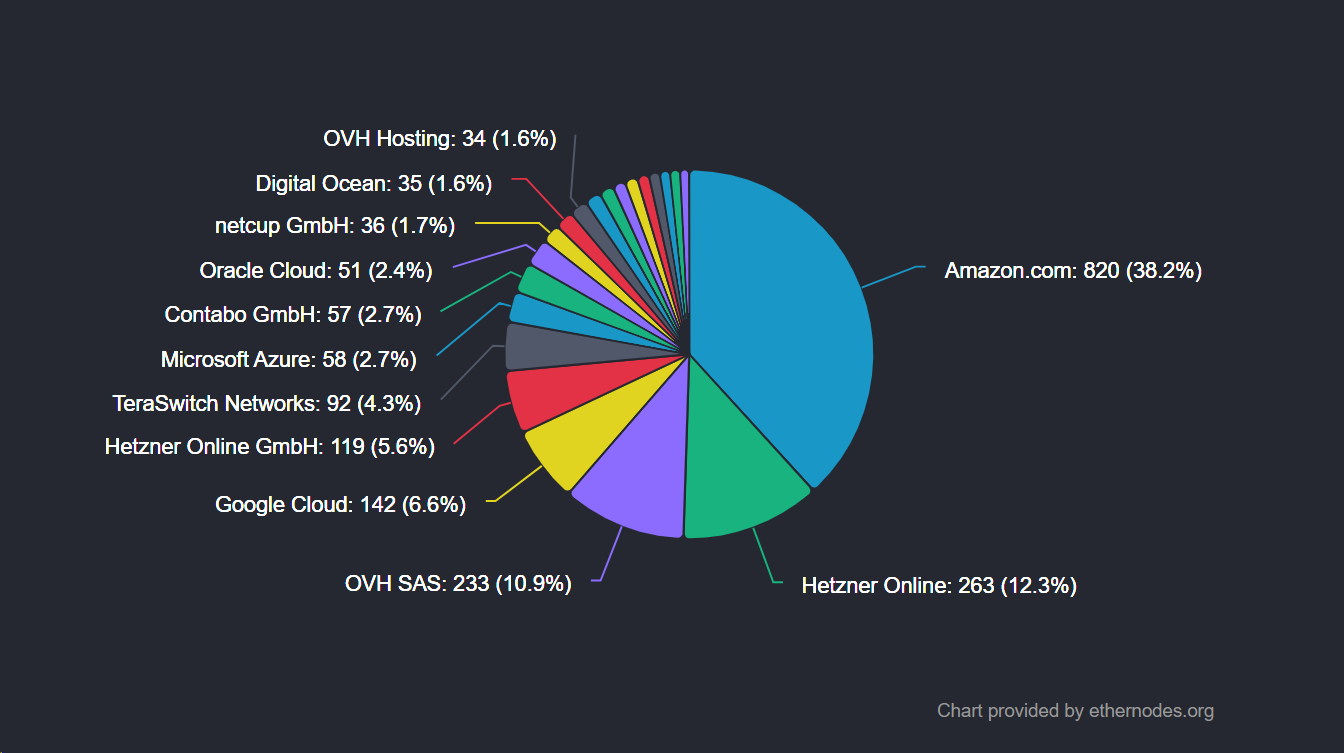
POKT Network solves this problem through a decentralized node “market”. Unlike Infura or Alchemy, the POKT network does not have nodes established by any team, and the redundant design ensures that POKT has achieved 99.9% uptime in the mainnet over the past three years.Currently, there are more than 15,000 nodes in the POKT network, distributed in 22 countries/regions.Infura and Alchemy are more like companies that provide node services and need to complete the construction, maintenance and operation of nodes themselves, while POKT Network focuses on building protocols and improving the incentive layer, attracting more nodes to join the network, and completing the matching between supply and demand. There is no need to build and operate nodes by itself.
2 DePIN Narrative: How POKT realizes RPC decentralization
The decentralized RPC node network is also an important module in the DePIN narrative. The core logic of DePIN is to use tokens to incentivize network participants to provide resources, and the network charges fees paid by demanders, forming a decentralized resource market. POKT Network uses POKT tokens to incentivize RPC nodes in different blockchain networks to join. Demanders request data or send transactions to RPC nodes through the POKT network, and at the same time pay usage fees to the network.
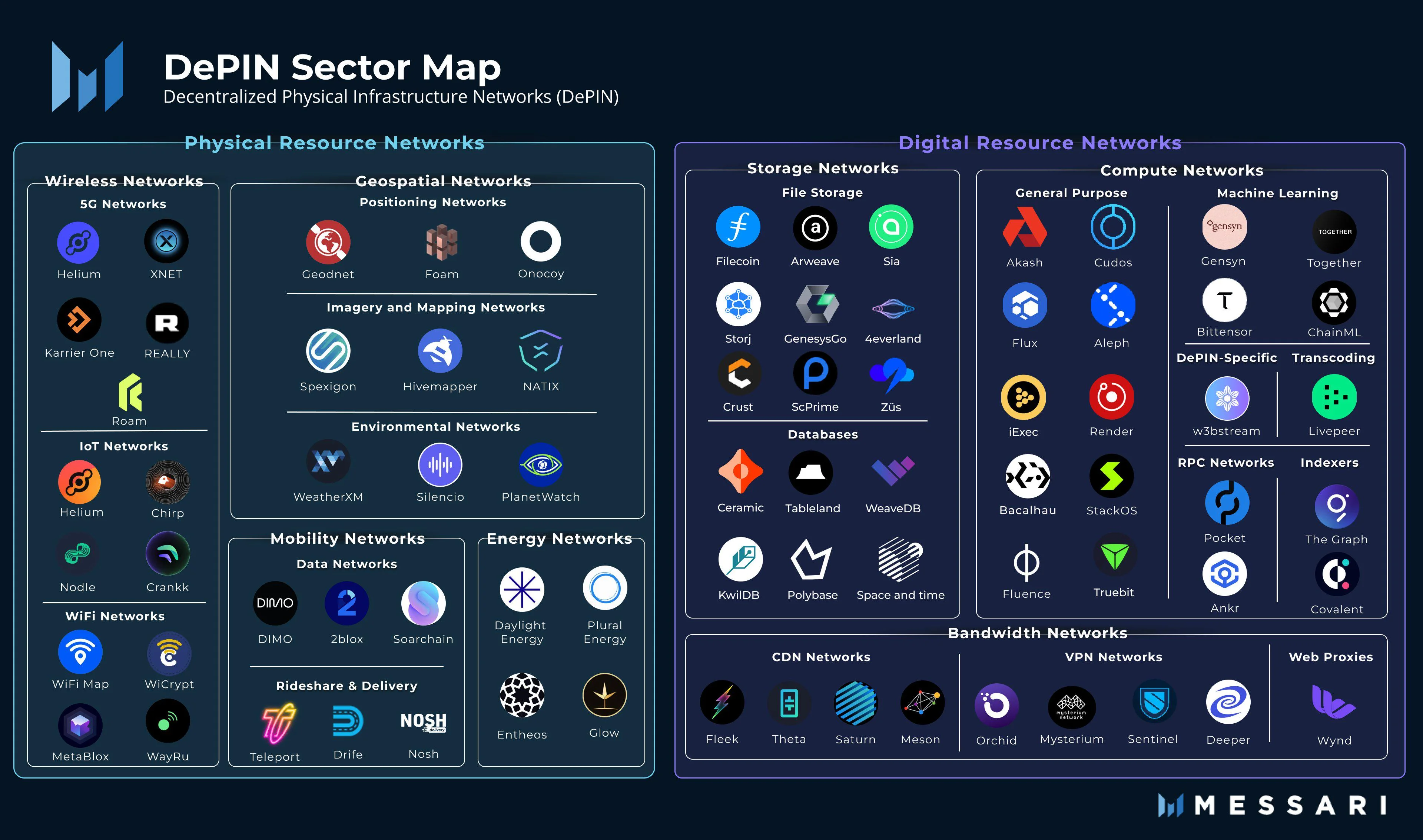
The modular architecture of POKT Network is as follows. The Gateway ecosystem replaces the previous single POKT Network front-end portal and is built on the basic layer of the RPC network and the POKT network to abstract the complexity of the integration protocol. Application developers access the RPC node group of the POKT network through the Gateway operator. Currently there are three Gateway providers, Grove, Nodies and the recently announced Liquify. Grove was rebranded from the former Pocket Network Inc and is the first portal on POKT Network. Nodies became POKT Network’s second Gateway provider in December 2023. It was founded by former AWS engineers and is also the provider of POKT Network’s public endpoints.
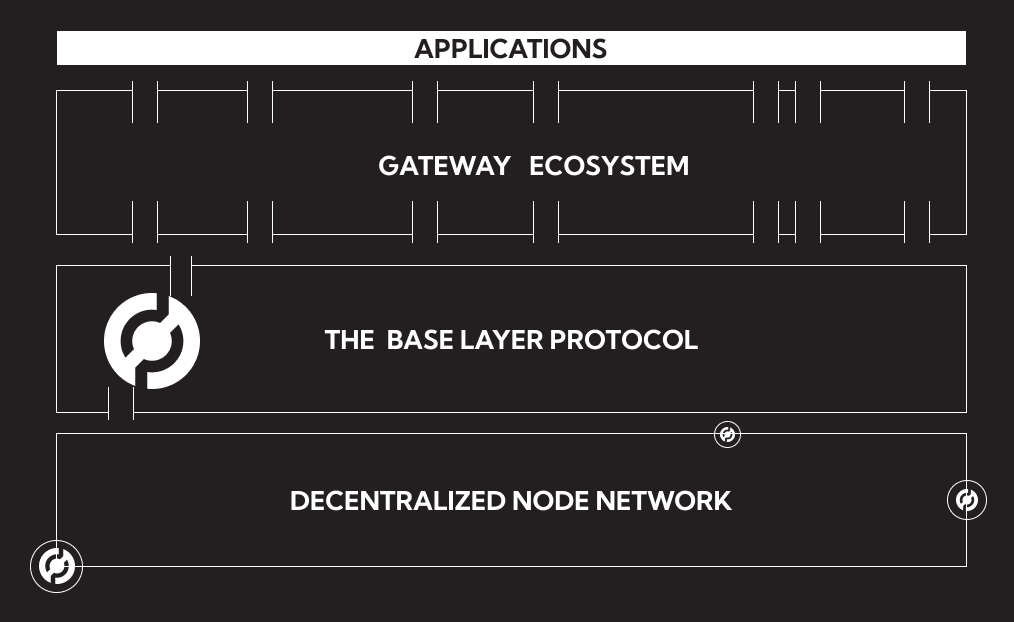
From the perspective of value transmission, users use the services of the Gateway provider and pay corresponding usage fees to the service provider; the Gateway provider pays the Gateway Operator Fee based on the number of relays sent to the POKT network every week, and the fee for each relay is 0.00000085 USD, through the destruction of POKT; POKT Network provides incentives to node operators participating in the network through POKT token inflation. A more detailed analysis of the token economic system and value transfer process will be carried out in the fifth part.
Establishing a Gateway ecosystem is one of the current development priorities of the POKT network, that is, the Gatewayverse strategy.The enrichment of Gateway will significantly reduce the cost for developers to access the POKT network and improve the service quality and competitiveness of the entire system. Gateway abstracts the complexity of direct access to the POKT network protocol. In the absence of a Gateway operator, application developers need to complete the following steps to send requests directly to the POKT network:
Generate an AAT (Application Authentication Token)
Send a request to the full node of the POKT network to obtain the latest node in the Session
Construct and sign the relay proof and submit it to a node in the Session
Get the nodes reply
Determine whether the reply is valid
Return this reply proxy to the Web Application
Gateway abstracts away processes such as retrieving Sessions and signing relay certificates, optimizing developer experience and providing ease of use, and provides innovation by providing value-added services. The POKT network is currently connecting with multiple organizations to introduce more Gateway providers. After completing the Shannon upgrade (expected to be launched on the Q2 mainnet in 2024), developers or RPC node operators can become Gateway service providers without permission. A series of development work to help build Gateway is underway. On February 8, 2024, Nodies released the open source Gateway Server, which is integrated with the POKT network protocol and sends and accepts RPC requests by maintaining a familiar HTTP JSON-RPC server interface, allowing development Developers can quickly use this set of tools to build a Gateway that meets their needs, further simplifying the difficulty of accessing the POKT protocol.
In summary, the POKT network will separate the operation of Gateway to achieve decentralization on the demand side, and will focus on the construction of the underlying RPC node network. The advantages of this development path include: (1) Providing more customized Gateway services , to meet the needs of different types of developers, and encourage operators to develop value-added services to optimize user experience; (2) Strengthen distribution power, each Gateway operator will become a distributor of the POKT network, thereby enhancing the BD capabilities of the entire network protocol, Drive demand-side growth; (3) All Gateways will not issue coins by default when cooperating with the POKT network, and use $POKT to complete transaction settlement, ensuring that the growth of the ecosystem will still be fully empowered by $POKT and will not cause Value is dispersed.
3 AI Narrative: Unlocking the potential of POKT Network as a universal data service provider
POKT Network is currently the leader in the underlying protocol for blockchain data services and is working to provide data services for a wider range of open databases and become the DePIN base layer for decentralized data relay services.
Two proposals for October 2023 –PIP-31 andPIP-33 , opening up the market for non-web3 native services for POKT, unleashing its potential as a universal RPC provider. RPC request service can not only be applied in blockchain, but also support other types of data services, such as LLM inference. Specifically, POKT can support open source LLM hosting for node operators to complete inference work based on open source large models. Unlike stateful blockchains that need to be continuously synchronized with the network, LLM is stateless and only needs to be updated in the model. Manually perform periodic updates when updating.
According to estimates by Michael ORourke, co-founder of POKT Network, opening up to the LLM inference market will increase POKT Network’s market by approximately 30%.
Currently, PIP-31 and PIP-33 have been approved by community voting. POKT’s decentralized node group can support the inference steps of hundreds of models. LLM inference will be the focus of the development of the POKT network in 2024. POKT official Twitter has begun publicizing its market expansion in LLM. The cost of decentralized providers will be significantly lower than that of centralized providers. The greatest competitiveness of the POKT network is its mature incentive mechanism and large-scale node group - the POKT protocol already has more than 15,000 nodes and is the largest decentralized node network in web3. It has a relatively strong imagination in this narrative. In addition, RPC nodes are the entrance for users to read and write blockchain data, and will also be of direct benefit to AI products that use blockchain data for reasoning. AI+crypto has become one of the core narratives in this cycle. The transformation of the POKT network to AI is still in its early stages and has not yet received full value discovery. It is still a good opportunity to ambush.
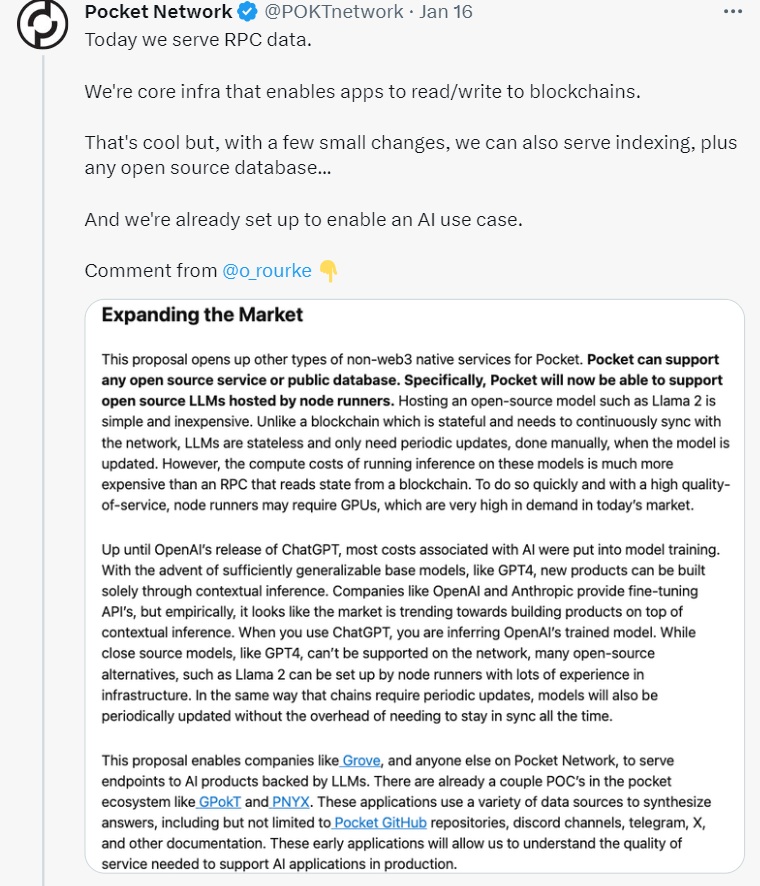
However, it should be noted that the current official detailed development plan and roadmap are unclear, and the computing cost and hardware requirements for running inference are high. Node operators may need GPUs, and the specific implementation possibility is unknown. We need to continue to pay attention to the follow-up in this direction. progress.
4 Comparison of track layout and business data
According to the track estimate of the founder of POKT Network, the current conservative number of daily paid RPC requests in the Web3 market is 100 B. Assuming that the cost per million requests is 3-6 US dollars, the total market value of Web3 RPC is 100 million per year. to $200 million. As the bull market approaches and more blockchain networks are built, the number of RPC requests will continue to increase.
In terms of track layout, POKT Network is currently the absolute leader in decentralized RPC nodes. Its main competitors will be centralized players such as Infura and Alchemy. Here, the POKT Network will be compared with the business data of major centralized RPC service providers. Compared.
Judging from business data, POKT Network currently has more than 15k RPC nodes distributed in 22 countries/regions. The average daily relay volume in the past year was 950 million times, with a peak of 2 billion times. Since November 2023, the number of relays in the POKT network has dropped significantly. The current daily number of relays is around 400-500 million times. This comes as Grove, the largest Gateway operator, declared independence, shutting down public endpoints and reducing its free tier. In terms of public chain distribution of data relay, the main demand comes from Ethereum, with the number of relays accounting for 15%.
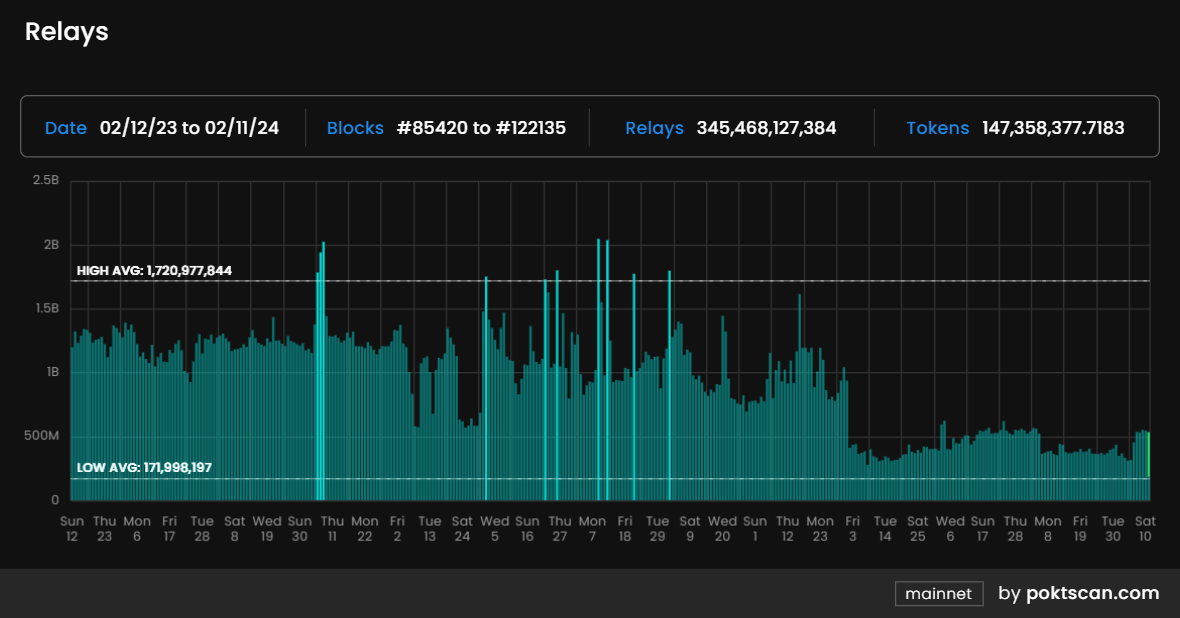
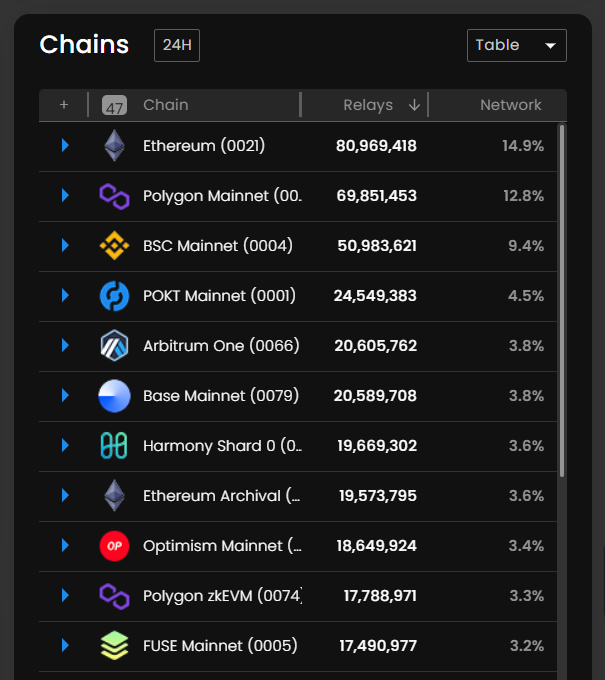
Judging from the number of relays, the market share of the POKT network is still very small. Centralized providers such as Infura and Alchemy are still the first choice for applications. Their daily data relay volume is estimated to be in the tens or even hundreds of billions. In terms of market competition, the POKT network still faces very strong opponents and severe competition. pattern, but also has sufficient room for market expansion.
Judging from the number of supported blockchains, POKT Network currently supports 75+ blockchain RPC requests. In contrast, Infura and Alchemy both support only 9 blockchains. The POKT network greatly improves the scalability of the ecosystem by attracting full nodes on different chains to provide services instead of building full nodes from scratch.
From the perspective of pricing plans, POKT Network and Infura both use Relay quantity for charging, while Alchemy and others use Compute units as pricing units. POKT Network currently charges $0.85 per million relays for Gateway. Taking Infuras Growth plan, the cheapest unit price, as an example, the charge per million relays is $6.67, which is about 8 times that of POKT Network. However, most developers currently access the POKT network through Gateway providers. These operators do not adopt subscription plans, but pay directly based on the number of Relays. Grove charges US$7.456 per million relays in addition to the free plan. Nodies charges $4.50 per million relays outside of the free plan and $3.40 for enterprise users. As the largest Gateway operator, Grove is priced on the expensive side, but with the increase in the number of Gateways and license-free Gateway access, the competitive market on the POKT network will gradually improve, and developers can also directly operate their own Gateways to access the POKT network. to reduce costs.
From the perspective of valuation comparison, there is currently no decentralized RPC provider that directly competes with POKT Network. Therefore, the projects that can provide reference for valuation comparison are:
(1) Centralized RPC providers: such as Infura and Alchemy;
(2) Web3 data track infrastructure: such as The Graph and Covalent.
The valuations of Infura (ConsenSys) and Alchemy are both much higher than that of POKT Network. This is also due to their higher market share and richer product portfolio. The competitive point of POKT Network lies in the argument of decentralization. If If the argument for decentralized infrastructure can be accepted by more investors and developers, POKT Network will have a unique competitive advantage.
The Graph/Covalent and POKT Network both belong to Web3 data infrastructure and are also classified as DePIN tracks by Messari. However, POKT Network is located upstream of the two. The valuation of The Graph is much higher than that of POKT, while the valuation of Covalent is relatively low. Low. At present, the entire decentralized data infrastructure track is in a relatively early stage, and valuations will increase as the demand for data in the bull market increases and the demand for decentralization increases.
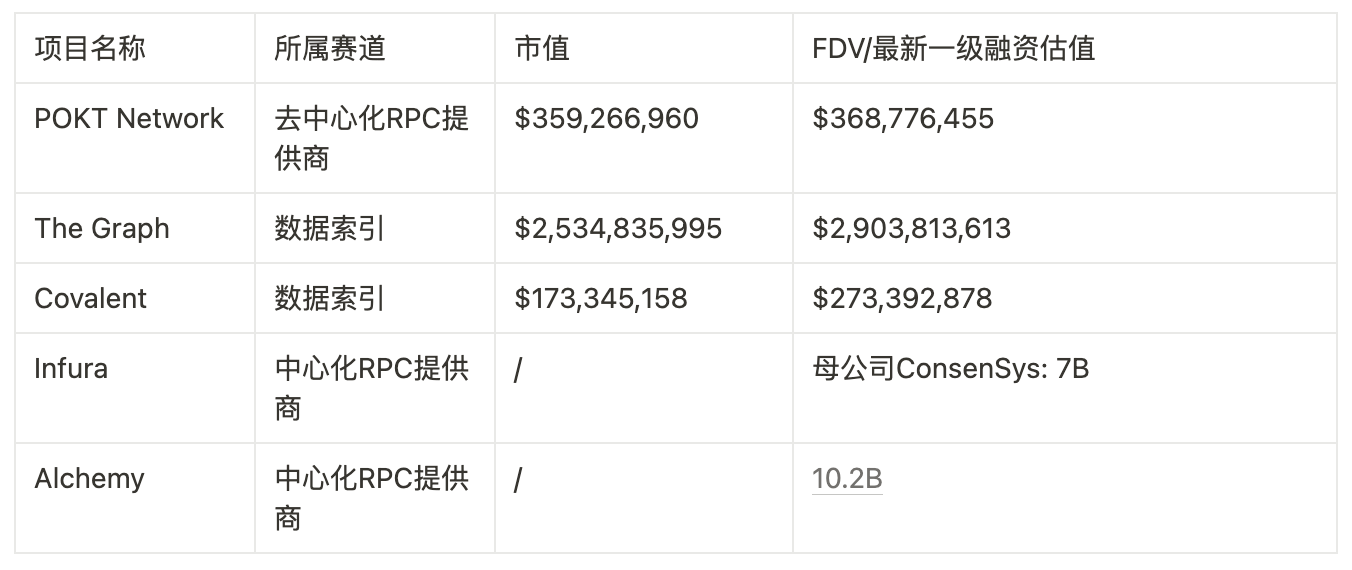
5 Token Economy and Chip Structure
5.1 Token economic system and value cycle
As mentioned earlier, the core logic of DePIN is to use tokens to incentivize network participants to provide resources. The basic mechanism of DePIN network construction is that individual suppliers provide corresponding hardware or services in order to obtain token incentives. In the early stage of the project, a high inflation rate is required to encourage supplier participation through higher token rewards; as the project gradually Mature, it is necessary to reduce the token inflation rate to avoid excessive token release from diluting token prices. Finally, it should gradually transition to an era of low inflation or even deflation. This is also true for POKT Network. A balanced and healthy economic system is crucial to the sustainability of the entire network.
From the supply side, the latest supply plan of POKT is determined by the proposal PUP-32 passed in June 2023. An average of 220k POKT will be minted every day, and the newly minted POKT will be distributed as follows:
85% distributed to node operators,
5% distributed to validators of the POKT network
10% goes into the DAO treasury
From the consumption side, the POKT network will destroy the service fees paid by the gateway provider. The current price of each gateway relay is US$0.00000085 (since the main market competitor, namely centralized RPC, adopts US dollar pricing, the POKT network also adopts US dollar pricing) . Based on the number of relays sent to the gateway operator every week, the service fee to be paid is calculated. This part of the fee will be calculated based on the seven-day average price of POKT. The corresponding number of POKT will then be destroyed every week. .
The token inflation rate of POKT will be determined by both the supply and the amount of destruction. As long as the supply remains relatively stable, relay pricing, the number of relays, and the price of POKT will all affect the token inflation rate. Judging from business data, the higher the pricing and the higher the number of relays on the POKT network, the lower the inflation rate of the network. The POKT Foundation is working hard to reduce its inflation rate and plans to eventually enter a deflationary economic era.
Judging from specific data, the growth rate of the total token supply (Monetary Base) has gradually slowed down in the past year. After the passage of PUP-32 in June 2023, the number of Minted POKT dropped significantly, with weekly releases remaining at around 1.5 M. POKT will be destroyed in May 2023. In the following period, the weekly destruction amount will be around 200k, but after November there will be a sharp decline with the reduction in the number of relays.
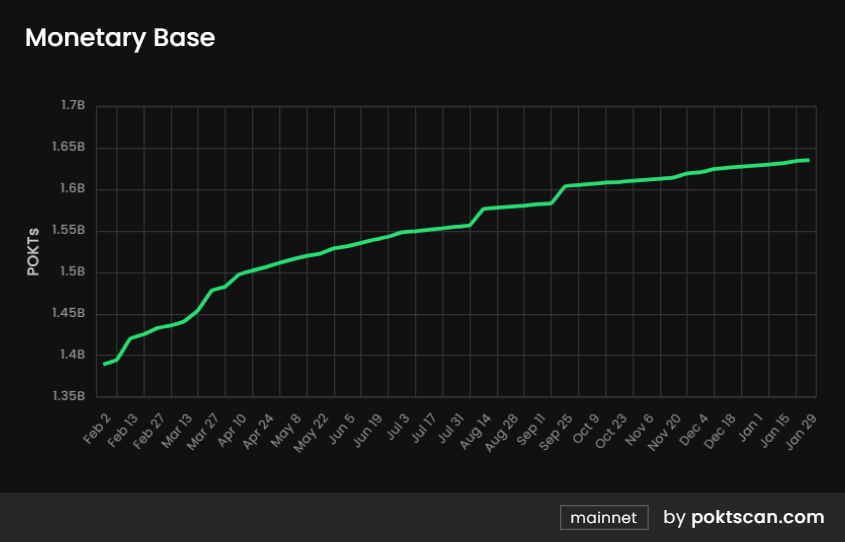
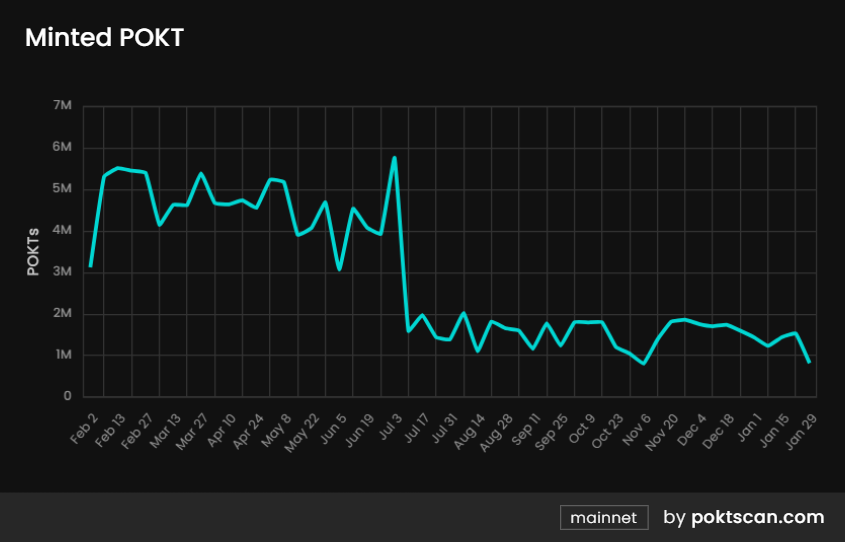
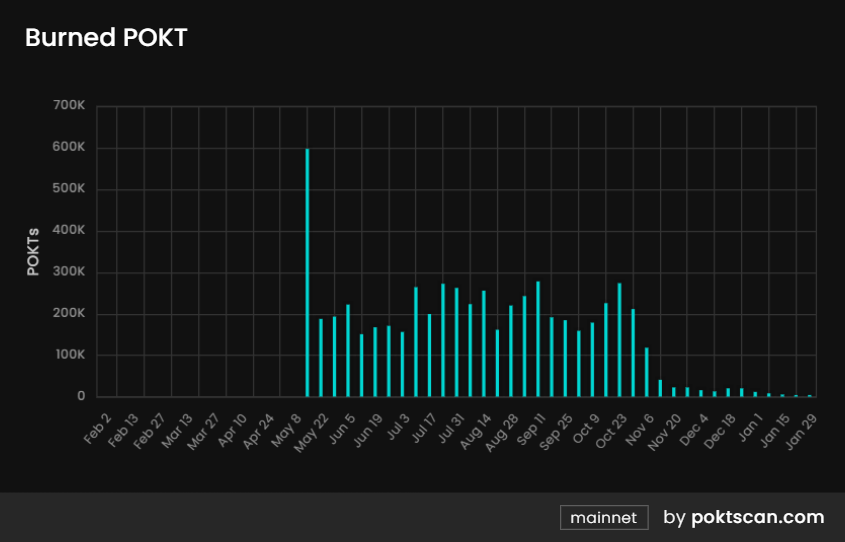
The circulation of tokens depends on both the total supply of tokens and the amount of pledges. Node operators need to pledge at least 15,000 POKT to join the node network. The top 1,000 nodes with pledge amount will become the verifiers of the POKT network. According to Poktscan, The minimum amount required to stake to become a validator is currently 75,100. Since June 2023, the total pledged amount of the POKT network has declined, causing Liquid POKT, which was previously basically stable, to begin to gradually grow after June.
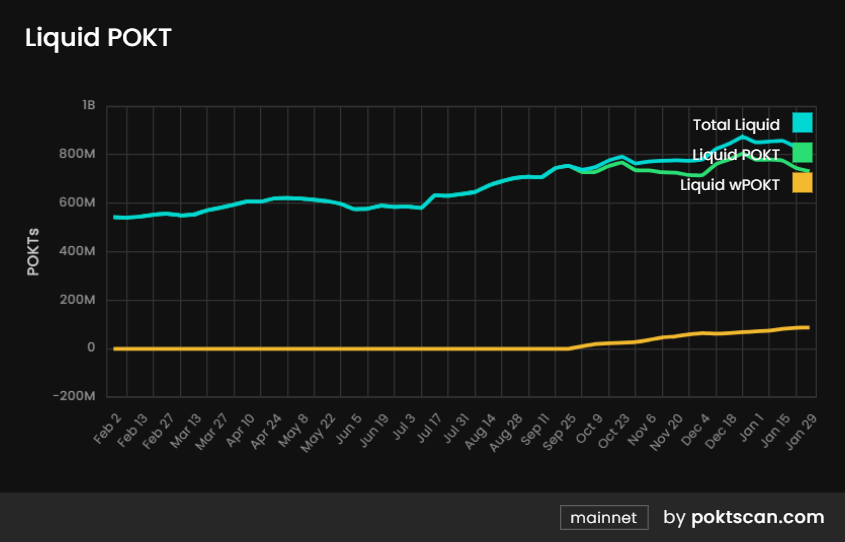
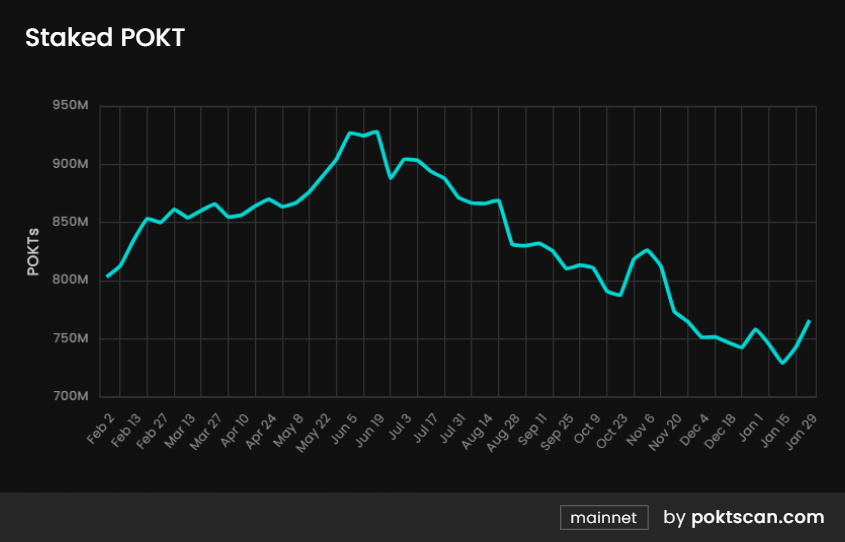
5.2 POKT chip structure and token performance
The initial supply of POKT is 649, 984, 998, and there is no maximum supply. The initial distribution of tokens and the unlocking schedule are as shown in the figure below. The current total supply is 1, 637, 686, 745, and the circulating supply is At 1, 548, 744, 251 (Coingecko data), the token unlocking is relatively complete, and most investors and team tokens have been unlocked.
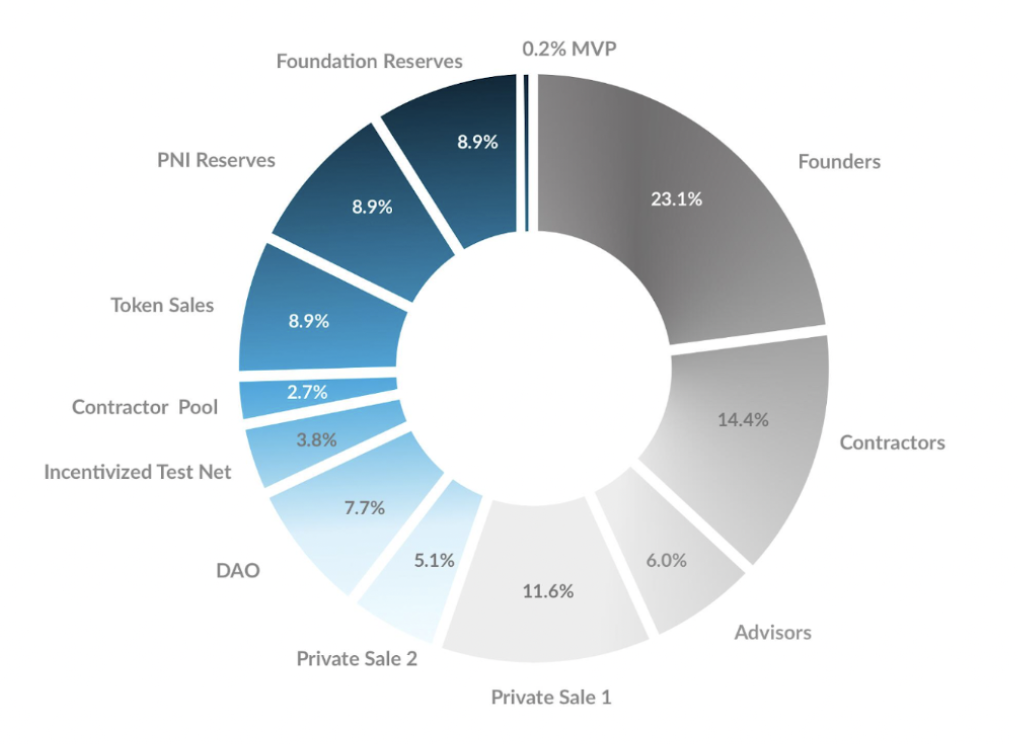
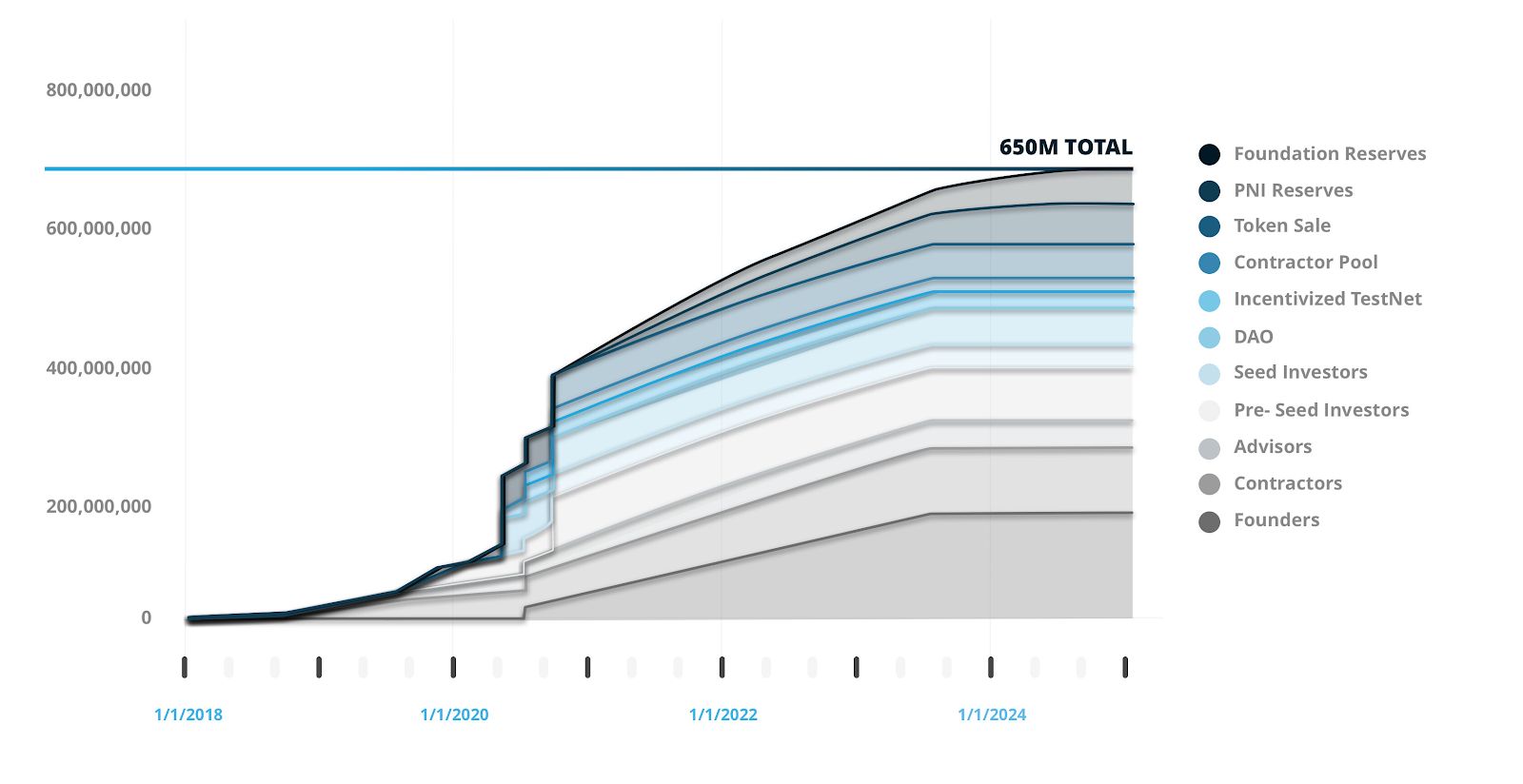
From the perspective of token distribution, the current amount of pledged tokens is 766, 214, 731, which is approximately 50% of the circulating supply, indicating that half of POKT has practical applications in the network. According to Poktscan data, the total number of addresses currently holding tokens is around 10,000, and the total number of positions held by the top 5 is 304, 546, 121. In addition to the amount of pledged tokens, the proportion of positions held by the top 5 is 38.2%, and the proportion of positions is relatively concentrated. .
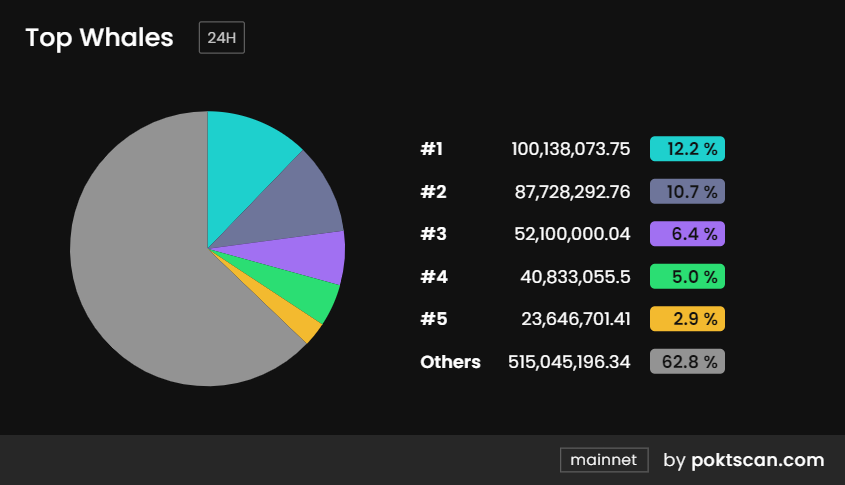
Judging from the token performance, the current market value of POKT is $359, 266, 960 and FDV is $368, 776, 455. In the past three months, it has risen about 10 times from the lowest point to the highest point, completing a round of value discovery, but it is still more than ten times away from the previous high point.
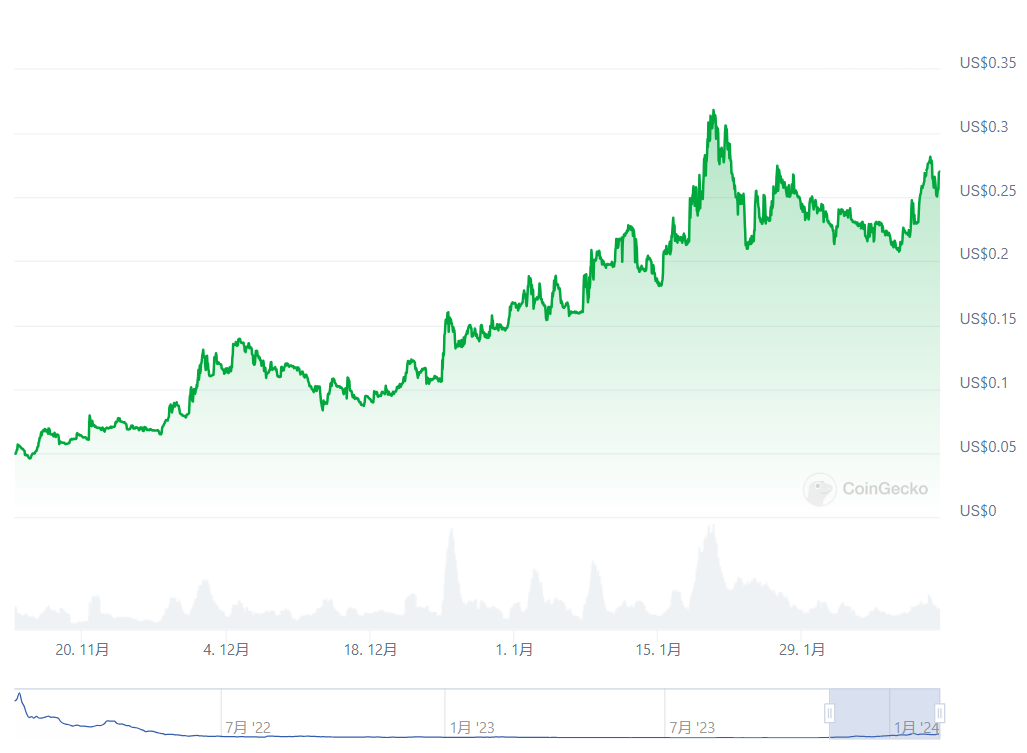
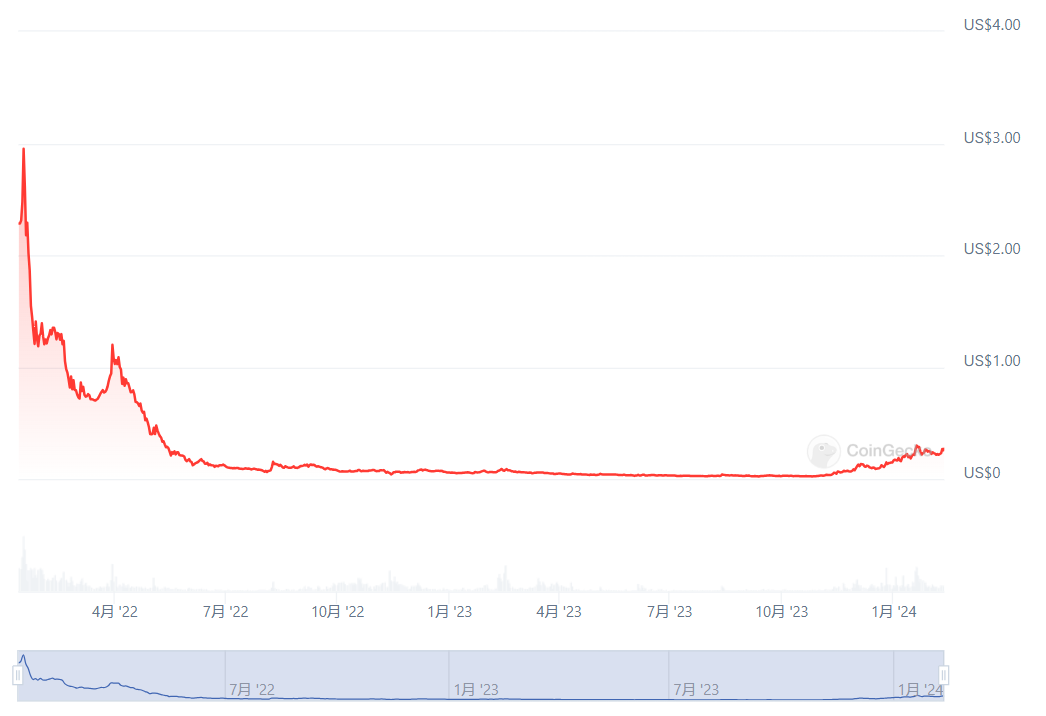
From the perspective of the trading market, the current main trading volume of POKT is concentrated on Gate. At present, POKT has not been listed on the first-tier exchanges, and there is a certain liquidity discount.
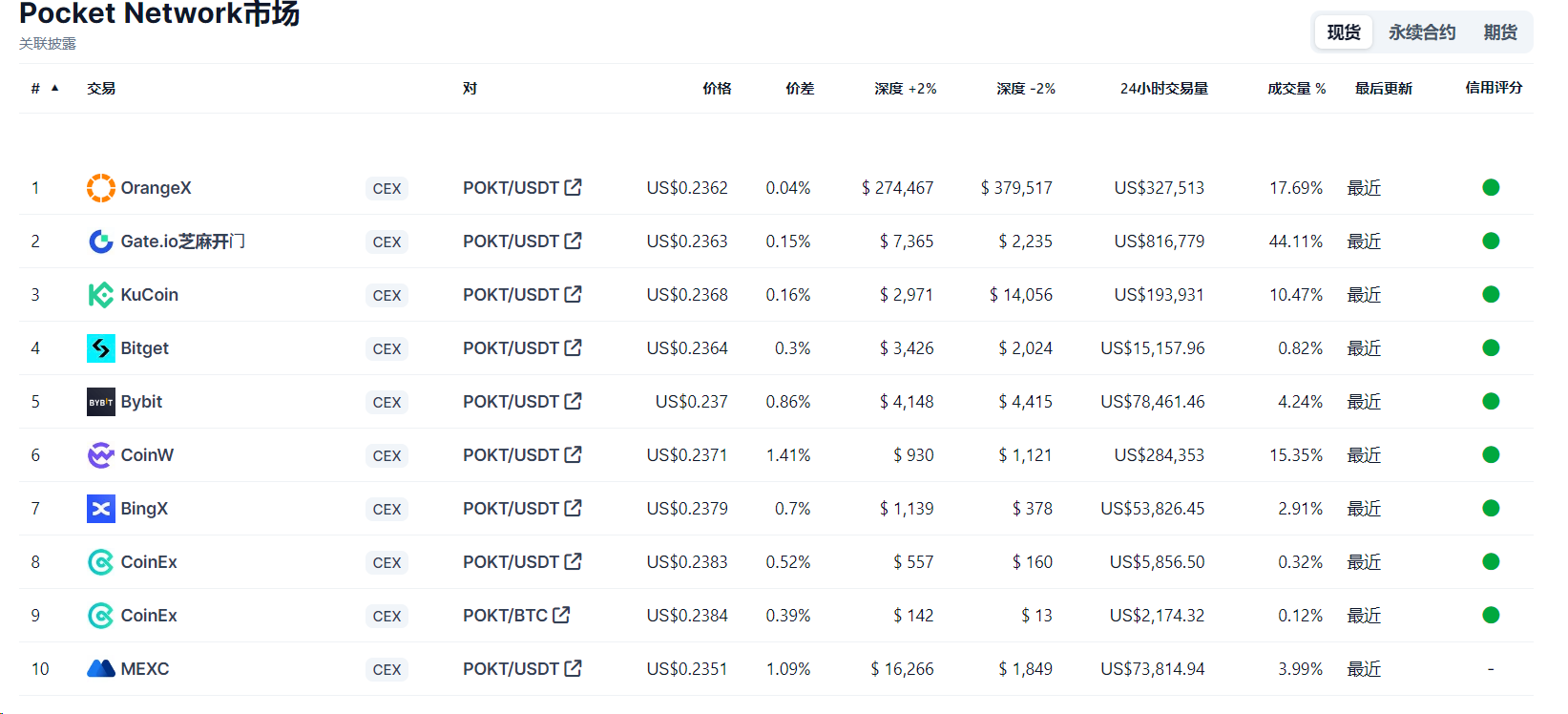
6 Conclusion: POKT network is transitioning to a sustainable development stage
From a fundamental perspective, we believe that the highlights of POKT Network mainly include the following points:
(1)Decentralized RPC node incentive protocol occupies an important ecological niche in the Web3 industry: The RPC node is the entrance for users and developers to interact with the blockchain and obtain and write data to the blockchain. It also occupies the bottom position of the entire Web3 data track. Its importance is self-evident. It is the center of the RPC node. ization has brought hidden dangers such as censored transactions and single points of failure. POKT Network has realized the provision of decentralized RPC nodes, filling the gap in this track, and there are currently no competitors in the decentralized RPC node provider track. Compared with centralized providers, POKT Network has higher scalability, lower maintenance and operation costs, lower usage fees and more stable infrastructure.
(2)The early launch of the DePIN network has been completed, it is in a relatively mature stage and is transitioning to the next stage of sustainable development.: POKT Network has completed the cold start of the node network, proving the feasibility of this protocol. It has now transitioned from early start to sustained development. This can be confirmed from the following two points: ①Business data: large-scale node group and The growing number of daily relays; ② Token economy: The continued decline of the inflation rate and the continuous adjustment of token economic parameters.
(3)Launch a new strategy on the demand side, and the existing modular structure and growth strategy are in line with the development stage: POKT Network launches the development strategy of Gatewayverse, separating the demand side into multiple independent gateway operators. The protocol itself will focus on becoming an underlying protocol that supports different gateway requirements, focusing on the stimulation and construction of node groups. Multiple gateway operators will enrich the types of products and services they provide and try to introduce non-Web3 native services including AI in the future, thereby increasing the application of the POKT network. As mentioned above, the POKT network has completed the supply-side construction of the DePIN network, and it is currently in line with the development stage to shift to a demand-side growth strategy.
fromFinanciallyLook, the POKT token has been fully unlocked, and the token inflation rate is continuously decreasing. And due to the existence of the burning mechanism, the token inflation rate is negatively related to the number of daily relays. The growing number of relays in the bull market will further inhibit Release of tokens. Half of the circulating supply of POKT tokens is used for pledge, and the chip structure is concentrated, which makes it a good target from a financial perspective.
fromNarrative aspectLook, POKT Network is currently focusing on two popular narratives, DePIN and AI, and the market is currently very enthusiastic about the hype for these two narratives.
Risk points that need attention in the future include:
Changes in market share among RPC nodes: Compared with centralized RPC service providers, POKT Network has a lower market share. The strategic adjustment of Gatewayverse has also led to a decrease in the number of daily relays. It is necessary to continue to pay attention to core business data. Variety.
Changes in the number of nodes and the amount of pledges: The number of nodes and the amount of pledges affect both the fundamentals and the stakes. In recent times, both the number of nodes and the amount of pledges have shown a short-term decline, becoming potential risk points.
The implementation of AI narrative: It is still unknown whether the node group can truly be applied to open source LLM inference. With the popularity of the AI track, the competition in AI decentralized inference services is currently fierce. The implementation of POKT Network in this track There are currently great unknowns in terms of performance and competitiveness.
about Us
Metrics Ventures is a data and research-driven crypto asset secondary market liquidity fund led by a team of experienced crypto professionals. The team has expertise in primary market incubation and secondary market trading, and plays an active role in industry development through in-depth on-chain/off-chain data analysis. MVC cooperates with senior influential figures in the encryption community to provide long-term enabling capabilities for projects, such as media and KOL resources, ecological collaboration resources, project strategies, economic model consulting capabilities, etc.
Welcome everyone to DM to share and discuss insights and ideas about the market and investment of crypto assets.
Our research content will be published simultaneously on Twitter and Notion, please follow:
Twitter: https://twitter.com/MetricsVentures
Notion: https://www.notion.so/metricsventures/Metrics-Ventures-475803b4407946b1ae6e0eeaa8708fa2?pvs=4
Recruiting! We are looking for traders with good salary and flexible working location.
If you have: bought sol below 40 ordi/ below 25 inj/ below 3.2 rndr/ below 10 tia if you meet any two of the above, please contact us at admin@metrics.ventures, ops@metrics.ventures





